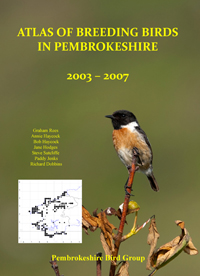Razorbill - 2003-07
 Wednesday, May 9, 2012 at 6:14PM
Wednesday, May 9, 2012 at 6:14PM Razorbills nest mostly in loose colonies scattered around broken cliffs in cracks and holes and less commonly on small ledges. In some places just a few birds might breed in suitable sites, so their distribution is slightly wider around the county than the gregarious Guillemot.
There are many fewer Razorbills than either Guillemots or Puffins but they occupy many more breeding sites around the coastline, especially along the south coast of the county and between Dinas Head and Newport along the north coast. Their distribution appears to have hardly changed during the last century.
Razorbills are not easy to count as they nest in scattered, often well concealed, small groups. In the late 1970s (but for some reason not on Skokholm until the late 1980) the count methodology was changed. Now all individuals attending the colony (i.e. observed on land), are counted, rather than using the older method of estimating “apparently occupied sites”. Accordingly population comparisons have since been made using a standard conversion factor of 0.67 across the UK, i.e. for every three birds counted there are two nest sites on average. Even so, because of the problems of seeing birds easily at some sites (where sometimes the birds are very evident and sometimes they hide very effectively, which is possibly weather related), and because of the simple variation in attendance from day to day, the census counts are at best reasonable estimates.
Because of these census variables, data needs to be accumulated over a long period of time to assess population changes. Information for Razorbills at their main breding sites has been collected for more than 40 years. The counts during the Seabird Colony register in 1985 – 1988 found a population of around 6,600 individuals in the county, half of them on Skomer. Seabird 2000 counts between 1998 and 2002 showed a significant increase to c. 9,000 birds during the period 2003–07, with almost 5,000 of them on Skomer. This is the highest known population level.
Steve Sutcliffe

Fieldwork 2003-07 (based on 490 tetrads)
Red = breeding confirmed = 27
Orange = breeding probable = 1
Yellow = possible breeding = not included
Total tetrads in which registered = 28 (5.7%)
 PBBA 2003-7,
PBBA 2003-7,  SJS in
SJS in  Razorbill
Razorbill 

Reader Comments